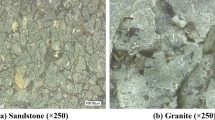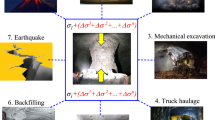Abstract
Under compression, gathering data related to the post-failure part of the stress–strain curve requires stiff servo-controlled testing systems. In unconfined conditions, data related to the post-peak region of the intact rock parameters are not common as pre-peak and peak state parameters of stress–strain behavior. For problems involving rock in the failed state around structures, proper choice of plastic constitutive laws and post-failure parameters is important for the modeling of the failed state. The aim is to relate commonly used intact rock parameters of pre-failure (tangent modulus E i and secant modulus E s) and peak strength (σ ci) states to parameters of the post-failure state under unconfined compression. Post-failure parameters are the drop modulus (D pf), representing the slope of the falling portion in brittle state, residual strength (σ cr), and dilatancy angle (ψ°). Complete stress–strain curves were generated for various intact rock of different origin. Seventy-three post-failure tests were conducted. Samples included in the testing program were chosen to represent rocks of different origin. Specimens of granite, rhyodacite, dunite, quartzite series, glauberite, argillite, marl, and lignite were used in the tests. The results from the pre-failure and peak state testing parts were processed and compared to the post-failure stress–strain parameters. For the estimation of post-failure parameters in terms of the pre-peak and peak states, the functional relations were assessed. It was found that the drop modulus D pf increases with rock strength σ ci, following a power function with an approximate power of two. With an exponential trend, the D pf/E s ratio increases with decreasing E i/σ ci ratio. Relations estimating the residual strength and dilatancy from the pre-peak and peak state parameters are in logarithmic and exponential functional forms, respectively.




















Similar content being viewed by others
References
Abdullah RA, Amin MFM (2008) Verification of post failure behaviour of rock using closed-circuit servo-controlled testing machine. Bull Geol Soc Malays 54:17–20
Alejano LR, Alonso E (2005) Considerations of the dilatancy angle in rocks and rock masses. Int J Rock Mech Min Sci 42:481–507
Alejano LR, Rodriguez-Dono A, Alonso E, Fdez-Manín G (2009) Ground reaction curves for tunnels excavated in different quality rock masses showing several types of post-failure behaviour. Tunn Undergr Space Technol 24:689–705
Arzúa J, Alejano LR (2013) Dilation in granite during servo-controlled triaxial strength tests. Int J Rock Mech Min Sci 61:43–56
Banyard JFP (2010) Geological controls on the Kiziltepe Epithermal Au-Ag deposit, Balikesir Province, western Turkey. MSc Dissertation, University of Exeter, Exeter, Devon, UK
Baud P, Wong T-F, Zhu W (2013) Effects of porosity and crack density on the compressive strength of rocks. Int J Rock Mech Min Sci. doi:10.1016/j.ijrmms.2013.08.031
Bieniawski ZT (1968) In situ strength and deformation characteristics of coal. Eng Geol 2:325–340
Bieniawski ZT (1969) In situ large scale testing of coal. In: Proceedings of the conference on in situ investigations in soils and rocks. British Geotechnical Society, London, pp 67–74
Bozkuş C (1992) Olur (Erzurum) Yöresinin Stratigrafisi. Stratigraphy of the Olur (Erzurum) region. Bull Geol Soc Turk 35:103–119 (in Turkish)
Çağatay A, Pehlivanoğlu H, Altun Y (1982) Cobalt-gold minerals in Küre pyritic copper deposits (Kastamonu Province, N. Turkey) and their economic values. Bull Miner Res Explor Inst Turk 93/94:100–117 (in Turkish with abstract in English)
Cook NGW, Hodgson K, Hojem JPM (1971) A 100 MN jacking system for testing coal pillars underground. J S Afr Inst Min Metall 71:215–224
Crowder JJ, Bawden WF (2004) A review of post-peak parameters and behaviour of rock masses: current trends and research. RocNews, Fall 2004. Available online at: http://www.rocscience.com/library/rocnews/Fall2004.htm. Accessed 10 April 2013
Cundall PA, Strack ODL (1979) A discrete numerical model for granular assemblies. Géotechnique 29(1):47–65. doi:10.1680/geot.1979.29.1.47
Ding X, Zhang L, Zhu H, Zhang Q (2013) Effect of model scale and particle size distribution on PFC3D simulation results. Rock Mech Rock Eng. doi:10.1007/s00603-013-0533-1
Ege İ, Tonbul S (2003) Geomorphology of Tufanbeyli basin and its near surroundings (Adana). Geogr Sci Bull 1(2):103–122 (in Turkish)
Erik YN (2010) The coalification process and use of biomarker data in the determination of paleoenvironmental characteristics—Kangal Coals (Sivas, Turkey). İstanb Geosci Bull 23(1):19–37
Fairhurst CE, Hudson JA (1999) Draft ISRM suggested method for the complete stress–strain curve for intact rock in uniaxial compression. Int J Rock Mech Min Sci 36:279–289
Goodman RE (1989) Introduction to rock mechanics, 2nd edn. Wiley, London
Helvacı C, Alaca O (1991) Geology and mineralogy of the Bigadiç borate deposits and vicinity. Miner Res Explor Bull Inst Turk 113:31–63 (in Turkish)
Hudson JA, Harrison JP (1997) Engineering rock mechanics: an introduction to the principles, 1st edn. Pergamon, an imprint of Elsevier Science, Oxford
Itasca Consulting Group, Inc. (2005) User manual for FLAC, Version 5.0, 3rd edn. Itasca Consulting Group, Inc., Minnesota
Jaeger JC, Cook NGW, Zimmerman RW (2007) Fundamentals of rock mechanics, 4th edn. Blackwell Publishing Ltd., UK
Jaiswal A, Shrivastva BK (2009) Numerical simulation of coal pillar strength. Int J Rock Mech Min Sci 46:779–788
Joseph TG, Barron K (2003) The post-failure characteristics of rock. Can Inst Min Metall Bull 96(1070):66–74
Kahraman S (2001) Evaluation of simple methods for assessing the uniaxial compressive strength of rock. Int J Rock Mech Min Sci 38:981–994
Li C, Prikryl R, Nordlund E (1998) The stress–strain behaviour of rock material related to fracture under compression. Eng Geol 49:293–302
Medhurst TP, Brown ET (1998) A study of the mechanical behaviour of coal for pillar design. Int J Rock Mech Min Sci 35:1087–1105
Ortí F, Gündoğan İ, Helvacı C (2002) Sodium sulphate deposits of Neogene age: the Kirmir formation, Beypazari basin, Turkey. Sediment Geol 146:305–333
Oygür V (1997) Anatomy of an epithermal mineralization: Mumcu (Balikesir-Sindirgi), Inner Western Anatolia, Turkey. Miner Res Explor Bull Inst Turk 119:29–39 (in Turkish)
Ozer U (2008) Environmental impacts of ground vibration induced by blasting at different rock units on the Kadikoy–Kartal metro tunnel. Eng Geol 100:82–90
Palchik V (2013) Is there link between the type of the volumetric strain curve and elastic constants, porosity, stress and strain characteristics? Rock Mech Rock Eng 46:315–326. doi:10.1007/s00603-012-0263-9
Palchik V, Hatzor YH (2004) The influence of porosity on tensile and compressive strength of porous chalks. Rock Mech Rock Eng 37(4):331–341. doi:10.1007/s00603-003-0020-1
Parlak O, Höck V, Delaloye M (2002) The supra-subduction zone Pozanti–Karsanti ophiolite, southern Turkey: evidence for high-pressure crystal fractionation of ultramafic cumulates. Lithos 65:205–224
Plaxis (2010) Material models manual. Plaxis, Delft, the Netherlands
Potyondy DO, Cundall PA (2004) A bonded-particle model for rock. Int J Rock Mech Min Sci 41(8):1329–1364. doi:10.1016/j.ijrmms.2004.09.011
Rocscience, Inc. (2012) Phase2, 8. Rocscience Inc., Toronto, Canada
Schöpfer MPJ, Abe S, Childs C, Walsh JJ (2009) The impact of porosity and crack density on the elasticity, strength and friction of cohesive granular materials: Insights from DEM modelling. Int J Rock Mech Min Sci 46(2):250–261
Şen Ö, Saraç C (2000) Kalburçayın (Kangal, Sivas) Linyit Yatağının Jeolojisi ve Blok Kriging Yöntemi ile Değerlendirilmesi. Geol Bull Turk 43:I21–I31 (in Turkish)
Tiwari RP, Rao KS (2006) Post failure behaviour of a rock mass under the influence of triaxial and true triaxial confinement. Eng Geol 84:112–129
Van Heerden WL (1975) In situ complete stress–strain characteristics of large coal specimens. J S Afr Inst Min Metall 75:207–217
Vermeer PA, de Borst R (1984) Non-associated plasticity for soils, concrete and rock. Heron 29(3):1–64
Wagner H (1974) Determination of the complete load deformation characteristics of coal pillars. In: Proceedings of the 3rd ISRM congress, Denver, CO, September 1974, pp 1076–1081
Wang Y, Tonon F (2009) Modeling Lac du Bonnet granite using a discrete element model. Int J Rock Mech Min Sci 46(7):1124–1135
Yagiz S (2009) Predicting uniaxial compressive strength, modulus of elasticity and index properties of rocks using the Schmidt hammer. Bull Eng Geol Environ 68:55–63. doi:10.1007/s10064-008-0172-z
Zhao XG, Cai M (2010) Influence of plastic shear strain and confinement-dependent rock dilation on rock failure and displacement near an excavation boundary. Int J Rock Mech Min Sci 47:723–738
Zheng H, Liu DF, Lee CF, Ge XR (2005) Principle of analysis of brittle-plastic rock mass. Int J Solids Struct 42:139–158
Author information
Authors and Affiliations
Corresponding author
Rights and permissions
About this article
Cite this article
Tutluoğlu, L., Öge, İ.F. & Karpuz, C. Relationship Between Pre-failure and Post-failure Mechanical Properties of Rock Material of Different Origin. Rock Mech Rock Eng 48, 121–141 (2015). https://doi.org/10.1007/s00603-014-0549-1
Received:
Accepted:
Published:
Issue Date:
DOI: https://doi.org/10.1007/s00603-014-0549-1




